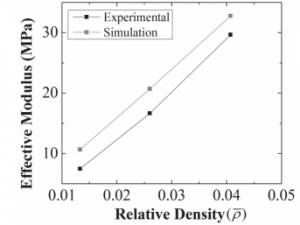Lattice structures are frequently found in additive manufacturing, as their complex forms are easy to make using 3D printing. The technology also makes it possible to construct them from multiple materials. Because of their high specific strength and stiffness, lattice structures are often used in the aerospace, defense and automotive industries. In a paper entitled “Compressive Behavior of Strut Reinforced Kagome Structures Fabricated by Fused Deposition Modeling,” a group of researchers investigates the compressive performance of modified Kagome unit cells.
Kagome is a type of lattice structure defined by the researchers as “a stretch dominated 3D truss structure derived from the design pattern of a woven basket.” A modified version of Kagome structure is strut reinforced Kagome (SRK), which has been shown to have better compressive properties than standard Kagome. For the study, the researchers used ABS to 3D print SRK structures.
“Uniaxial compression tests were carried out in Shimadzu Universal Testing Machine using 10 kN load-cell, and compression load was applied under displacement control at a rate of 0.1 mm/min,” the researchers explain. “Video extensometer TRViewX was used to measure the accurate displacement between the faceplates. The engineering stress-strain data are obtained from the measured force (F) and displacement (h). The stress was calculated by dividing the force by the effective area which is obtained in terms of truss length ( l = 2c) 2 3 c2, whereas the strain is obtained by dividing the displacement by the core height.”
 The tests showed that the peak strength and effective modulus increase with the decrease in the slenderness ratio. In addition, SRK structures show different failure behavior with the change in the slenderness ratio.
The tests showed that the peak strength and effective modulus increase with the decrease in the slenderness ratio. In addition, SRK structures show different failure behavior with the change in the slenderness ratio.
“The core with lowest relative density (d =2.4 mm, h = 35mm) shows the failure within the linear elastic regime,” the researchers continue. “As the slenderness ratio is very high, the struts failed by elastic buckling without any yielding. With the increase in the relative density (d =2.4 mm, h = 25 mm), there is some plastic deformation before reaching the peak strength as shown in the Figure 2. With further increase in relative density (d = 3 mm, h = 25 mm), we can see the significant plastic nonlinearity before reaching the peak strength. The stress gradually decreases with the increase in the strain.”
 The vertical struts in all the samples started to deform after substantial compression. Plastic bending of the vertical strut results in the distortion of the upper and lower part of the SRK, leading to the deformation of the slanted struts. Further compression leads to the formation of surface cracks on the tensile side of the strut. With further loading, the cracks open, leading to the bending of the structure, additional cracks on all sides, and eventual softening and collapse of the structure.
The vertical struts in all the samples started to deform after substantial compression. Plastic bending of the vertical strut results in the distortion of the upper and lower part of the SRK, leading to the deformation of the slanted struts. Further compression leads to the formation of surface cracks on the tensile side of the strut. With further loading, the cracks open, leading to the bending of the structure, additional cracks on all sides, and eventual softening and collapse of the structure.
“The anisotropic material behavior and the porous nature of FDM printed structure have led to the discrepancies in the numerical and experimental results,” the researchers conclude. “The performance of SRK unit structure can be further improved by the variation in diameter of the slanted and vertical struts to optimize it for a given density.”
Authors of the paper include Rinoj Gautam, Sridhar Idapalapati, and Estella Siew Lee Koh.
Discuss this and other 3D printing topics at 3DPrintBoard.com or share your thoughts below.
Subscribe to Our Email Newsletter
Stay up-to-date on all the latest news from the 3D printing industry and receive information and offers from third party vendors.
You May Also Like
3D Printing News Briefs, April 27, 2024: Research, Digital Dentistry, Cycling, & More
We’re starting today’s 3D Printing News Briefs with some research into 3D printed luminescent quantum-dot polymer architectures and free-form laser beam shaping, and then on to an open source 4-axis...
HP & INDO-MIM Collaborate to Boost Metal 3D Printing in India
HP Inc. and INDO-MIM, a US- and India-based supplier of metal injection molding (MIM) powders and contract manufacturer, have announced that the two companies will collaborate to accelerate additive manufacturing...
3D Printing News Briefs, February 17, 2024: Shot Blasting, Service Bureaus, & More
In today’s 3D Printing News Briefs, we’re starting out with post-processing, as SKZ Würzburg is using a shot blast system from AM Solutions for its research. Moving on to business,...
3D Printing News Unpeeled: Not That Kind of Organ 3D Printing
GKN Aerospace will create a 150 jobs in Trollhattan Sweden with an investment of $60 million part of which comes from the Swedish Energy Agency’s Industriklivet initiative. The investment will...































